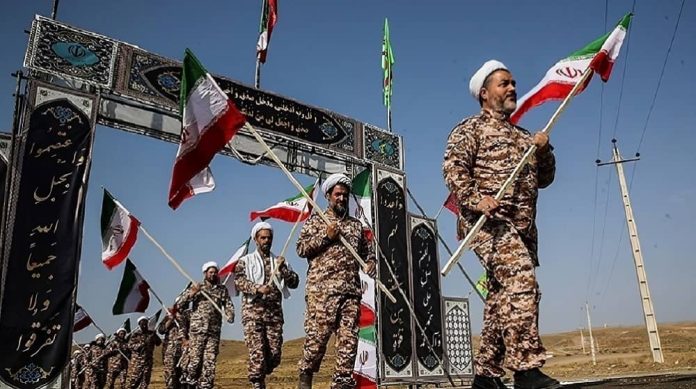Why Containing Iran’s Regime is a Myth

Written by
Mehdi Oghbai
iran irgc mullahs march parade (1)
Three minutes read
The United States and the United Kingdom, with support from several military partners, carried out retaliatory strikes on the Houthi militants in Yemen early Friday, January 12, following months of escalatory attacks upon commercial shipping as well as the coalition warships that had been tasked with defending it. More than 100 missiles reportedly struck 60 Houthi targets at 16 distinct sites within Yemen, leading American and British officials to conclude that they had significantly impeded the ability of the Iran-backed rebel group to continue threatening the security of maritime traffic in the Red Sea.
However, the Pentagon seemed to acknowledge the possibility of the Yemeni militants rebounding in the near future, insofar as it emphasized the United States’ readiness to carry out further retaliatory strikes as needed.
On Monday, January 16, Houthi rebels launched a missile that hit a U.S.-owned ship just off the coast of Yemen in the Gulf of Aden. This incident occurred less than a day after they had fired an anti-ship cruise missile toward an American destroyer in the Red Sea.
In addition to the Houthis’ maritime attacks, there have been more than 100 attacks since mid-October upon coalition military assets, by Iran-backed militant groups in both Iraq and Syria. Both categories of attack have demonstrated similar reliance upon one-way attack drones of the type that have increased within the regime’s arsenal during recent years.
Why Firmness Will Prevent War with #Iranhttps://t.co/k4SwUpabzi
— NCRI-FAC (@iran_policy) January 15, 2024
Tehran has also been widely condemned for supplying those drones to Russia for use in its war on Ukraine, and even though it consistently denies accusations of weapons smuggling, but attack sites in Ukraine, Saudi Arabia, and elsewhere have yielded components that independent experts determined to be proof of Iranian manufacture.
Furthermore, the regime’s Navy did arguably bolster the Houthi threat early this month when it captured another commercial vessel, the Greek-owned St. Nikolas oil tanker, ostensibly to settle a dispute over its prior forfeiture of US-sanctioned Iranian oil that it had loaded via illicit ship-to-ship transfer when operating under a different name, Suez Rajan.
At the start, the official narrative of the Houthi attacks was that they were targeting ships with significant connections to Israel, either through ownership or through the companies operating them. This later evolved into a threat against any ships going to or leaving Israeli ports. But in reality, the Tehran-initiated aggression has already affected global trade and economies.
The absence of vetoes in the UN Security Council vote last week surely reflects the fact that the Houthi threat to shipping in the Red Sea poses a danger to the economy even to Iran’s allies. Indeed, Tehran’s efforts to distance itself from the attacks have only become more futile as those attacks have escalated.
Last night, the Islamic Revolutionary Guard Corps (IRGC) launched ballistic missiles into Iraq’s territory, near the Kurdish city of Erbil. The IRGC targeted what they claimed to be a Mossad spy base in northern Iraq and “anti-Iran terror groups” in Syria, further intensifying the tensions in the region.
The US and UK strike against the Houthis was in response to an attack carried out by the group on the previous day. The attack involved more than 20 missiles and drones no doubt supplied by the Iranian regime.
On the same day as those attacks, sources in Ukraine highlighted the persistence of Iran’s smuggling of those weapons, noting that a cargo plane had just arrived in Moscow which was most likely carrying drones for use in the ongoing Russian offensive. Other sources stated that Russia was poised to receive new batches of both missiles and drones in the near future, including surface-to-surface missiles with a range of nearly 200 miles and a model of drone known as Shahed-107 which has been developed specifically for use by Russia and which may be equipped with technology to detect American and British aerial defense systems.
Iran Proxies- Iraq’s Hashd al-Shaabi (Popular Mobilization Forces) – Part 1
In essence, everything is pointing towards a heightened complexity of events in the delicate state of the Middle East, reaching a juncture that requires strategic decision-making. After being appeased for decades, the terrorist regime in Iran has evolved into a threat that can no longer be ignored.
Meanwhile, despite the looming specter of war with the United States, the regime cannot afford to stand down and abandon its Middle East strategy. It is unwilling to redirect its focus towards addressing internal challenges such as a restive society, disgruntled elites, and a security apparatus with low morale. Consequently, it is likely to escalate tensions until the threat of a significant ground invasion becomes inevitable.
Western powers frequently lean on mere fire superiority, banking on the notion that intimidation alone will eventually subdue Tehran. This strategy reveals a naive assumption that they can elicit a rational response from their adversary. However, their misconception portrays Tehran as a conventional ambitious regime, a monster to be tamed. They fail to recognize that this regime is not vying for regional dominance; rather, it is locked in a struggle for survival. The true vulnerability lies in the regime’s fear of its own people, making it susceptible to defeat by the force it fears most.

